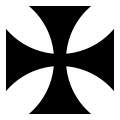Charles I of Austria
- "Karl I" redirects here. For the Prince of Liechtenstein, see Karl I of Liechtenstein.
| Blessed Charles I & IV | |
|---|---|
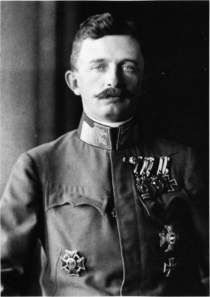 |
|
|
|
|
| Reign | 21 November 1916 - 12 November 1918 (1 year, 356 days) |
| Predecessor | Francis Joseph I |
|
|
|
| Reign | 21 November 1916 - 16 November 1918 (1 year, 360 days) |
| Coronation | 30 December 1916 (aged 29) |
| Predecessor | Francis Joseph I |
| Spouse | Zita of Bourbon-Parma |
| Issue | |
| Otto, Crown Prince of Austria Archduchess Adelheid Robert, Archduke of Austria-Este Archduke Felix Archduke Karl Ludwig Archduke Rudolf Archduchess Charlotte Archduchess Elisabeth |
|
| House | House of Habsburg-Lorraine |
| Father | Archduke Otto Franz |
| Mother | Princess Maria Josepha of Saxony |
| Born | 17 August 1887 Persenbeug-Gottsdorf, Austria-Hungary |
| Died | 1 April 1922 (aged 34) Madeira, Republic of Portugal |
| Burial | Igreja Nossa Senhora do Monte, Madeira, Muri Abbey, Switzerland (heart) |
Charles I (Karl Franz Joseph Ludwig Hubert Georg Otto Marie von Habsburg-Lothringen, English: Charles Francis Joseph Louis Hubert George Otto Mary of Habsburg-Lorraine, Hungarian: IV. Károly or Károly Ferenc József, Italian: Carlo Francesco Ludovico Giorgio Ottone Maria d'Asburgo Lorena) (17 August 1887 – 1 April 1922) was (among other titles) the last ruler of the Austro-Hungarian Empire. He was the last Emperor of Austria, the last King of Hungary[1], the last King of Bohemia, Croatia and the last King of Galicia and Lodomeria and the last monarch of the House of Habsburg-Lorraine. He reigned as Charles I as Emperor of Austria and Charles IV as King of Hungary from 1916 until 1918, when he "renounced participation" in state affairs, but did not abdicate. He spent the remaining years of his life attempting to restore the monarchy until his death in 1922. Following his beatification, he has become commonly known as Blessed Karl.
Contents |
Life
Early life
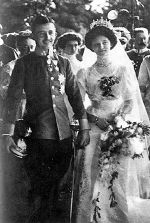
Charles was born on August 17, 1887, in the Castle of Persenbeug in Lower Austria. He was the son of Archduke Otto Franz of Austria (1865–1906) and Princess Maria Josepha of Saxony (1867–1944); he was also a nephew of Archduke Francis Ferdinand of Austria-Este. As a child, Charles was reared a devout Catholic. In 1911, Charles married Princess Zita of Parma.
Charles became heir-presumptive with the assassination of Archduke Franz Ferdinand, his uncle, in Sarajevo in 1914, the event which precipitated World War I. Charles' reign began in 1916, when his grand-uncle, Francis Joseph I died. Charles also became a Generalfeldmarschall in the Austro-Hungarian Army.
Reign
On 2 December 1916, he took over the title of Supreme Commander of the whole army from Archduke Frederick. His coronation occurred on December 30. In 1917, Charles secretly entered into peace negotiations with France. Although his foreign minister, Ottokar Czernin, was only interested in negotiating a general peace which would include Germany as well, Charles himself, in negotiations with the French with his brother-in-law, Prince Sixtus of Bourbon-Parma, an officer in the Belgian Army, as intermediary, went much further in suggesting his willingness to make a separate peace. When news of the overture leaked in April 1918, Charles denied involvement until the French Prime Minister Georges Clemenceau published letters signed by him. This led to Czernin's resignation, forcing Austria-Hungary into an even more dependent position with respect to its seemingly-wronged German ally.
The Austro-Hungarian Empire was wracked by inner turmoil in the final years of the war, with much tension between ethnic groups. As part of his Fourteen Points, US President Woodrow Wilson demanded that the Empire allow for autonomy and self-determination of its peoples. In response, Charles agreed to reconvene the Imperial Parliament and allow for the creation of a confederation with each national group exercising self-governance. However, the ethnic groups fought for full autonomy as separate nations, as they were now determined to become independent from Vienna at the earliest possible moment.
Foreign Minister Baron Istvan Burián asked for an armistice based on the Fourteen Points on October 14, and two days later Charles issued a proclamation that radically changed the nature of the Austrian state. The Poles were granted full independence with the purpose of joining their ethnic brethren in Russia and Germany in a Polish state. The rest of the Austrian lands were transformed into a federal union composed of four parts—German, Czech, South Slav and Ukrainian. Each of the four parts was to be governed by a federal council, and Trieste was to receive a special status. However, Secretary of State Robert Lansing replied four days later that the Allies were now committed to the causes of the Czechs, Slovaks and South Slavs. Therefore, autonomy for the nationalities was no longer enough. In fact, a Czechoslovak provisional government had joined the Allies on October 14, and the South Slav national council had opted to join Serbia in forming a large South Slav state.
The Lansing note effectively ended any efforts to keep the Empire together. One by one, the nationalities proclaimed their independence; even before the note the national councils had been acting more like provisional governments. Charles' political future became uncertain. On October 31, Hungary officially ended the personal union between Austria and Hungary. Nothing remained of Charles' realm except the Danubian and Alpine provinces, and he was challenged even there by the German Austrian State Council. His last prime minister, Heinrich Lammasch, advised him that it was fruitless to stay on.
Non-abdication
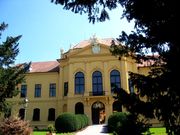
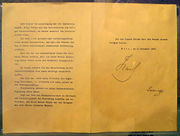
On November 11, 1918—the same day as the armistice ending the war between allies and Germany—Charles issued a carefully worded proclamation in which he recognized the Austrian people's right to determine the form of the state and "relinquish(ed) every participation in the administration of the State."[2] He also released his officials from their oath of loyalty to him. On the same day the Imperial Family left Schönbrunn and moved to Castle Eckartsau, east of Vienna. On November 13, following a visit of Hungarian magnates, Charles issued a similar proclamation for Hungary.
Although it has widely been cited as an "abdication", that word was never mentioned in either proclamation[3] and privately Charles left no doubt that he believed himself to be the rightful emperor. Addressing Cardinal Friedrich Gustav Piffl, he wrote:
I did not abdicate, and never will. (...) I see my manifesto of November 11 as the equivalent to a cheque which a street thug has forced me to issue at gunpoint. (...) I do not feel bound by it in any way whatsoever.[4]
Charles had deliberately avoided using the word abdication in hopes that the people of either Austria or Hungary would vote to recall him. Instead, on November 12, the day after he issued his proclamation, the independent Republic of German Austria was proclaimed, followed by the proclamation of the Hungarian Democratic Republic on November 16. An uneasy truce-like situation ensued and persisted until March 23, 1919, when Charles left for Switzerland, escorted by the commander of the small British guard detachment at Eckartsau, Lt. Col. Edward Lisle Strutt. As the Imperial Train left Austria on March 24, Charles issued another proclamation in which he confirmed his claim of sovereignty, declaring that "whatever the national assembly of German Austria has resolved with respect to these matters since November 11 is null and void for me and my House."[5]
Although the newly-established republican government of Austria was not aware of this "Manifesto of Feldkirchen" at this time (it had been dispatched only to the Spanish King and to the Pope through diplomatic channels), the politicians now in power were extremely irritated by the Emperor's departure without an explicit abdication. On April 3, 1919, the Austrian Parliament passed the Habsburg Law which banished the Habsburgs from Austrian territory unless they renounced all intentions of reclaiming the throne and accepted the status of ordinary citizens. Another law, passed on the same day, abolished all nobility in Austria.
In Switzerland, Charles and his family briefly took residence at Castle Wartegg near Rorschach at Lake Constance, and moved to Château de Prangins at Lake Geneva on May 20, 1919.
|
||||||||||||||||||||||||||||||||||||||||||||||
Attempts to reclaim throne of Hungary
Encouraged by Hungarian royalist ("legitimists"), Charles sought twice in 1921 to reclaim the throne of Hungary, but failed largely because Hungary's regent, Miklós Horthy (the last admiral of the Austro-Hungarian Navy), refused to support him. Horthy's failure to support Charles' restoration attempts is often described as "treasonous" by royalists. Critics suggest that Horthy's actions were more firmly grounded in political reality than the King of Hungary and his supporters. Indeed, the neighbouring countries had threatened to invade Hungary if Charles tried to regain the throne. Later in 1921, the Hungarian parliament formally dethroned the Habsburgs.
Madeira exile and death
After the second failed attempt at restoration in Hungary, Charles and the pregnant Zita were briefly quarantined at Tihany Abbey. On November 1, 1921 they were taken to the Danube harbor city of Baja, made to board the British monitor HMS Glowworm, and were removed to the Black Sea where they were transferred to the light cruiser HMS Cardiff.[6][7] They arrived in their final exile, the Portuguese island of Madeira, on November 19, 1921. Determined to prevent a third restoration attempt, the Council of Allied Powers had agreed on Madeira because it was isolated in the Atlantic and easily guarded.[8]
Originally the couple and their children (who joined them only on February 2, 1922) lived at Funchal at the Villa Vittoria, next to Reid's Hotel, and later moved to Quinta do Monte. Compared to the imperial glory in Vienna and even at Eckartsau, conditions there were certainly impoverished[9], although not nearly comparable to the bleak conditions under which most of Charles' former subjects had to make a living after the war. During his stay on the island, his personal chaplain was the priest, Father Jorge de Faria e Castro.
Charles would not leave Madeira again. On March 9, 1922 he caught a cold walking into town and developed bronchitis which subsequently progressed to severe pneumonia. Having suffered two heart attacks he died of respiratory failure on April 1 in the presence of his wife (who was pregnant with their eighth child) and 9-year old Crown Prince Otto, retaining consciousness almost to the last moment.[10] His remains except for his heart are still kept on the island, in the Church of Our Lady of Monte, in spite of several attempts to move them to the Habsburg Crypt in Vienna. His heart, and that of Empress Zita, repose in the Loreto Chapel of Muri Abbey.
Assessment
Historians have been mixed in their evaluations of Charles and his reign. One of the most critical has been Helmut Rumpler, head of the Habsburg commission of the Austrian Academy of Sciences, who has described Charles as "a dilettante, far too weak for the challenges facing him, out of his depth, and not really a politician." However, others have seen Charles as a brave and honourable figure who tried as Emperor-King to halt World War I. The English writer, Herbert Vivian, wrote:
"Karl was a great leader, a Prince of peace, who wanted to save the world from a year of war; a statesman with ideas to save his people from the complicated problems of his Empire; a King who loved his people, a fearless man, a noble soul, distinguished, a saint from whose grave blessings come."
Furthermore, Anatole France, the French novelist, stated:
"Emperor Karl is the only decent man to come out of the war in a leadership position, yet he was a saint and no one listened to him. He sincerely wanted peace, and therefore was despised by the whole world. It was a wonderful chance that was lost."
All of these various viewpoints give weight to the words of Pope Saint Pius X during an audience with a young Charles: "I bless Archduke Charles, who will be the future Emperor of Austria and will help lead his countries and peoples to great honor and many blessings - but this will not become obvious until after his death."
Beatification
The Roman Catholic Church has praised Charles for putting his Christian faith first in making political decisions, and for his perceived role as a peacemaker during the war, especially after 1917. The Church considered his brief rule to have expressed Roman Catholic social teaching, and he created a social legal framework which survives in part to this day.
Charles has been solemnly declared "Blessed" in the ceremony of beatification. During the Mass of Beatification on 3 October 2004, Pope John Paul II stated:
The decisive task of Christians consists in seeking, recognizing and following God's will in all things. The Christian statesman, Charles of Austria, confronted this challenge every day. To his eyes, war appeared as "something appalling". Amid the tumult of the First World War, he strove to promote the peace initiative of my Predecessor, Benedict XV.
From the beginning, the Emperor Charles conceived of his office as a holy service to his people. His chief concern was to follow the Christian vocation to holiness also in his political actions. For this reason, his thoughts turned to social assistance.
The cause or campaign began in 1949 when testimony of his holiness was collected in the Archdiocese of Vienna. In 1954, he was declared venerable, the first step in the process of beatification. The League of Prayers established for the promotion of his cause has created a website.[11] Cardinal Christoph Schönborn of Vienna has been the Church's sponsor for his beatification.
Recent milestones
- On 14 April 2003, the Vatican's Congregation for the Causes of Saints in the presence of Pope John Paul II, promulgated Charles of Austria's "heroic virtues."
- On 21 December 2003, the Congregation certified, on the basis of three expert medical opinions, that a miracle in 1960 occurred through the intercession of Charles. The miracle attributed to Charles was the scientifically-inexplicable healing of a Brazilian nun with debilitating varicose veins; she was able to get out of bed after she prayed for his beatification.
- On 3 October 2004, he was beatified by Pope John Paul II. The Pope also declared 21 October, the date of Charles' marriage in 1911 to Princess Zita, as Charles' feast day. The beatification has caused controversy because of the mistaken belief that Charles authorized the Austro-Hungarian Army's use of poison gas during World War I,[12] when in fact he was the first, and only, world leader during the war who banned its use.
- On January 31, 2008, an ecclesiastic tribunal, after a 16-month investigation, formally recognized a second miracle attributed to Charles I (required for his Canonization as a Saint in the Catholic Church); in an uncommon twist, the Florida woman claiming the miracle cure is not Catholic, but Baptist. [13]
Quotes
- "Now, we must help each other to get to Heaven."[14] Addressing Empress Zita on October 22, 1911, the day after their wedding.
- "I am an officer with all my body and soul, but I do not see how anyone who sees his dearest relations leaving for the front can love war."[15] Addressing Empress Zita after the outbreak of World War I.
- "I have done my duty, as I came here to do. As crowned King, I not only have a right, I also have a duty. I must uphold the right, the dignity and honor of the Crown.... For me, this is not something light. With the last breath of my life I must take the path of duty. Whatever I regret, Our Lord and Savior has led me."[16] Addressing Cardinal János Csernoch after the defeat of his attempt to regain the Hungarian throne in 1921. The British Government had vainly hoped that the Cardinal would be able to persuade him to renounce his title as King of Hungary.
- "I must suffer like this so my people will come together again."[17] Spoken in Madeira, during his last illness.
- "I can't go on much longer... Thy will be done... Yes... Yes... As you will it... Jesus!"[18] Reciting his last words while contemplating a crucifix held by Empress Zita.
Official grand title
| Monarchical styles of Emperor Charles I of Austria |
|
|---|---|
.png) |
|
| Reference style | His Imperial Majesty |
| Spoken style | Your Imperial Majesty |
| Alternative style | My Lord |
His Imperial and Royal Apostolic Majesty,
Charles the First,
By the Grace of God, Emperor of Austria, Apostolic King of Hungary, of this name the Fourth, King of Bohemia, Dalmatia, Croatia, Slavonia, and Galicia, Lodomeria, and Illyria; King of Jerusalem, Archduke of Austria; Grand Duke of Tuscany and Cracow, Duke of Lorraine and of Salzburg, of Styria, of Carinthia, of Carniola and of the Bukovina; Grand Prince of Transylvania; Margrave of Moravia; Duke of Upper and Lower Silesia, of Modena, Parma, Piacenza and Guastalla, of Auschwitz and Zator, of Teschen, Friuli, Ragusa and Zara; Princely Count of Habsburg and Tyrol, of Kyburg, Gorizia and Gradisca; Prince of Trent and Brixen; Margrave of Upper and Lower Lusatia and in Istria; Count of Hohenems, Feldkirch, Bregenz, Sonnenberg; Lord of Trieste, of Cattaro, and in the Windic March; Grand Voivode (Grand Duke) of the Voivodship (Duchy) of Serbia.
Children
| Name | Birth | Death | Notes |
|---|---|---|---|
| Crown Prince Otto | November 20 1912 | married (1951) Princess Regina of Saxe-Meiningen and Hildburghausen (1925-2010) and has seven children. | |
| *Archduchess Adelheid | January 3 1914 | October 2 1971 | |
| *Archduke Robert | February 8 1915 | February 7 1996 | married (1953) Princess Margherita of Savoy-Aosta (b. April 7 1930) and had five children. |
| *Archduke Felix | May 31 1916 | married (1952) Princess Anna-Eugénie of Arenberg (b. July 5 1925 d. June 9 1997) and had seven children. | |
| *Archduke Karl Ludwig | March 10, 1918 | December 11, 2007 | married (1950) Princess Yolanda of Ligne (b. May 6 1923) and had four children. |
| *Archduke Rudolf | September 5 1919 | May 15 2010 | married (1953) Countess Xenia Tschernyschev-Besobrasoff (b. June 11 1929 d. September 20 1968) and had four children. Married (secondly) (1971) Princess Anna Gabriele of Wrede (b. September 11 1940) and has one child. |
| *Archduchess Charlotte | March 1, 1921 | July 23, 1989 (aged 68) | married (1956) George, Duke of Mecklenburg (b. 5 October [O.S. 22 September] 1899 d. July 6 1963). |
| *Archduchess Elisabeth | May 31 1922 | January 7 1993 | married (1949) Prince Heinrich of Liechtenstein (b. August 5 1916 d. April 17 1991) and had five children. |
Gallery
 Charles in royal hussar uniform |
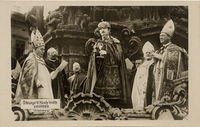 King Charles taking his oath as part of the coronation ceremonies |
Tomb of Charles I |
Ancestors
| Ancestors of Charles I of Austria | ||||||||||||||||||||||||||||||||||||||||||||||||||||||||||||||||||||||||||||||||||||||||||||||||||||||||||||||||||||||||||||||||||||||||||||||||||||||||||||||||||||||||||||||||||||||||||||||||||||||||||||||||||||||||||||||||||||||||||||||||||||||||||||||||||||||||||||||||||||||||||||||||||||||||||||||||||||||||||||||||||||||||||||||||||||||||||||||||||||||||||||||||||||||||||||||||||||||||||||||||||||||||||||||||||||||||||||||||||||||||||||||||||||||||||||||||||||||||||||||||||||||||||||||||||||||||||||||||||||||||||||||||||||||||||||||||||
|---|---|---|---|---|---|---|---|---|---|---|---|---|---|---|---|---|---|---|---|---|---|---|---|---|---|---|---|---|---|---|---|---|---|---|---|---|---|---|---|---|---|---|---|---|---|---|---|---|---|---|---|---|---|---|---|---|---|---|---|---|---|---|---|---|---|---|---|---|---|---|---|---|---|---|---|---|---|---|---|---|---|---|---|---|---|---|---|---|---|---|---|---|---|---|---|---|---|---|---|---|---|---|---|---|---|---|---|---|---|---|---|---|---|---|---|---|---|---|---|---|---|---|---|---|---|---|---|---|---|---|---|---|---|---|---|---|---|---|---|---|---|---|---|---|---|---|---|---|---|---|---|---|---|---|---|---|---|---|---|---|---|---|---|---|---|---|---|---|---|---|---|---|---|---|---|---|---|---|---|---|---|---|---|---|---|---|---|---|---|---|---|---|---|---|---|---|---|---|---|---|---|---|---|---|---|---|---|---|---|---|---|---|---|---|---|---|---|---|---|---|---|---|---|---|---|---|---|---|---|---|---|---|---|---|---|---|---|---|---|---|---|---|---|---|---|---|---|---|---|---|---|---|---|---|---|---|---|---|---|---|---|---|---|---|---|---|---|---|---|---|---|---|---|---|---|---|---|---|---|---|---|---|---|---|---|---|---|---|---|---|---|---|---|---|---|---|---|---|---|---|---|---|---|---|---|---|---|---|---|---|---|---|---|---|---|---|---|---|---|---|---|---|---|---|---|---|---|---|---|---|---|---|---|---|---|---|---|---|---|---|---|---|---|---|---|---|---|---|---|---|---|---|---|---|---|---|---|---|---|---|---|---|---|---|---|---|---|---|---|---|---|---|---|---|---|---|---|---|---|---|---|---|---|---|---|---|---|---|---|---|---|---|---|---|---|---|---|---|---|---|---|---|---|---|---|---|---|---|---|---|---|---|---|---|---|---|---|---|---|---|---|---|---|---|---|---|---|---|---|---|---|---|---|---|---|---|---|---|---|---|---|---|---|---|---|---|---|---|---|---|---|---|---|---|---|---|---|---|---|---|---|---|---|---|---|---|---|---|---|---|---|---|---|---|---|---|---|---|---|---|---|---|---|---|---|---|---|---|---|---|---|---|---|---|---|---|---|---|---|---|---|---|---|---|---|---|---|---|---|---|---|---|---|---|---|---|---|---|---|---|---|---|---|---|---|---|---|---|---|---|---|---|---|---|---|---|---|---|---|---|---|---|---|---|---|---|
|
||||||||||||||||||||||||||||||||||||||||||||||||||||||||||||||||||||||||||||||||||||||||||||||||||||||||||||||||||||||||||||||||||||||||||||||||||||||||||||||||||||||||||||||||||||||||||||||||||||||||||||||||||||||||||||||||||||||||||||||||||||||||||||||||||||||||||||||||||||||||||||||||||||||||||||||||||||||||||||||||||||||||||||||||||||||||||||||||||||||||||||||||||||||||||||||||||||||||||||||||||||||||||||||||||||||||||||||||||||||||||||||||||||||||||||||||||||||||||||||||||||||||||||||||||||||||||||||||||||||||||||||||||||||||||||||||||
See also
- Otto von Habsburg, Charles' oldest son and head of the Habsburg family
- Austria-Hungary
- Ukrainian Austrian internment
- List of heirs to the Austrian throne
|
|||||||||||||||||||||||||||||||
Notes
- ↑ Charles (I), . (2009). In Encyclopædia Britannica. Retrieved April 19, 2009, from Encyclopædia Britannica Online: http://www.britannica.com/EBchecked/topic/106679/Charles-I
- ↑ http://www.firstworldwar.com/source/abdication_karl.htm
- ↑ Kings and Queens of Hungary & Princes of Transylvania, by István Gombás published by Corvina, Budapest, 2002 (ISBN 963-13-5152-1)
- ↑ Die Presse. Unanhängige Tageszeitung für Österreich. November 8, 2008. German online version dated Vov. 7, 2008 [1] accessed March 24, 2009
- ↑ Portisch H: Österreich I. Die unterschätzte Republik. Verlag Kremayr & Scheriau, Vienna 1989. p. 117
- ↑ Gordon Brook-Shepherd Uncrowned Emperor - The Life and Times of Otto von Habsburg, Hambledon Continuum, London 2003. ISBN 1852855495.
- ↑ The New York Times, Nov. 5, 1921 (accessed May 4, 2009)
- ↑ The New York Times, Nov. 6, 1921 (accessed May 4, 2009)
- ↑ Blessed Emperor Charles, Prince of Peace for a United Europe, a Roman Catholic pamphlet, Nihil Obstat: Archdiocese of Vienna, 6.7.2005, K1238/05.
- ↑ The New York Times, April 2, 1922 (accessed May 4, 2009)
- ↑ http://www.emperor-charles.org
- ↑ "Emperor and mystic nun beatified". BBC News. 2004-10-03. http://news.bbc.co.uk/1/hi/world/europe/3710810.stm. Retrieved 2008-08-08.
- ↑ GOODMAN, TANYA Miracle in our midst: Central Florida woman’s cure may lead to sainthood for Blessed Karl of Austria Florida Catholic Feb. 8, 2008
- ↑ James and Joanna Bogle, "A Heart for Europe," page 35.
- ↑ Bogle, "A Heart for Europe," page 54.
- ↑ Bogle, "A Heart for Europe," page 137.
- ↑ Bogle, "A Heart for Europe," page 143.
- ↑ Bogle, "A Heart for Europe," page 144.
External links
 Media related to Karl I of Austria at Wikimedia Commons
Media related to Karl I of Austria at Wikimedia Commons- Karl von Habsburg-Lothringen
- Blessed Emperor Charles League of Prayers
|
Charles I of Austria
Born: 17 August 1887 Died: 1 April 1922 |
||
| Regnal titles | ||
|---|---|---|
| Preceded by Franz Joseph I |
Emperor of Austria 1916–1918 |
Succeeded by Karl Seitz as President of Austria |
| King of Hungary 1916–1918 |
Succeeded by Mihály Károlyi as Provisional President of Hungary |
|
| Austro-Hungarian royalty | ||
| Preceded by Archduke Franz Ferdinand |
Heir to the Austrian-Hungarian throne 28 June 1914 – 21 November 1916 |
Succeeded by Otto von Habsburg |
| Titles in pretence | ||
| Titles extant before dissolution of Austria-Hungary |
— TITULAR — Emperor of Austria 1918 – 1 April 1922 |
Succeeded by Crown Prince Otto |
| — TITULAR — King of Hungary, Bohemia, Croatia and Galicia 1918 – 1 April 1922 |
||
| Preceded by Archduke Franz Ferdinand |
— TITULAR — Duke of Modena 28 June 1914 – 16 April 1917 Reason for succession failure: Title abolished in 1860 |
Succeeded by Archduke Robert |
| — TITULAR — Archduke of Austria-Este 28 June 1914 – 16 April 1917 Reason for succession failure: Dissolution of Austria-Hungary |
||
|
|||||
|
||||||||||||||||||||||||||||||||||||||||||||||||||||||||||||||
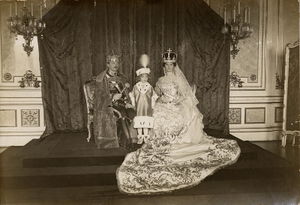
.png)
